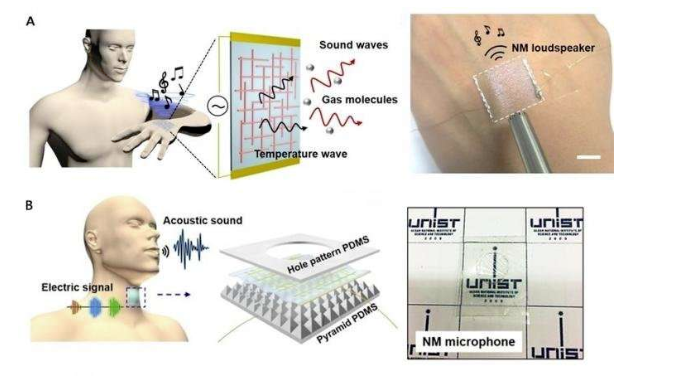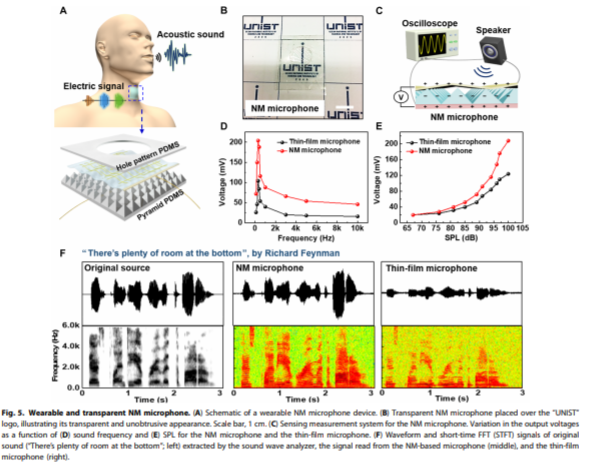A team of researchers from Ulsan National Institute of Science and Technology (UNIST) in South Korea has developed an ultrathin, and transparent wearable device that is capable of turning your skin into a loudspeaker. The device has been created to help the hearing and speech impaired people. However, it has potential applications in other domains such as wearable IoT sensors, and healthcare devices.

Skin-attachable NM loudspeaker
This new device is created with conductive hybrid nanomembranes (NMs) with nanoscale thickness, comprising an orthogonal silver nanowire array embedded in a polymer matrix. This helps substantially enhance the electrical as well as mechanical properties of ultrathin polymer NMs. There is no loss in the optical transparency because of the orthogonal array structure.
“Here, we introduce ultrathin, conductive, and transparent hybrid NMs that can be applied to the fabrication of skin-attachable NM loudspeakers and microphones, which would be unobtrusive in appearance because of their excellent transparency and conformal contact capability” as mentioned in the research paper.
Hybrid NMs help significantly enhance the electrical and mechanical properties of ultrathin polymer NMs, which can then be intimately attached to the human skin. After this, the nanomembrane is used as a loudspeaker which can be attached to almost anything to produce sounds.
The researchers also introduced a similar device, which acts as a microphone that can be connected to smartphones and computers for unlocking voice-activated security systems.
Skin-attachable and transparent NM loudspeaker
The researchers fabricated a skin-attachable loudspeaker using hybrid NMs. This speaker is capable of emitting thermoacoustic sound with the help of temperature-induced oscillation of the surrounding air.
This temperature oscillation is caused by Joule heating of the orthogonal AgNW array upon the application of an AC voltage.
The sound emitted from the NM loudspeaker is then analyzed with the help of an acoustic measurement system. “We used a commercial microphone to collect and record the sound produced by the loudspeaker. To characterize the sound generation of the loudspeaker, we confirmed that the sound pressure level (SPL) of the output sound increases linearly as the distance between the microphone and the loudspeaker decreases” reads the research paper.
Wearable and transparent NM microphone
The researchers also designed a wearable and transparent microphone using hybrid NMs combined with micropatterned PDMS (NM microphone). This microphone is capable of detecting sound and recognizing a human voice. These wearable microphones are sensors, which are attached to a speaker’s neck for sensing the vibration of the vocal folds.

The skin-attachable NM microphone comprises a hybrid NM mounted to a micro pyramid-patterned polydimethylsiloxane (PDMS) film. This sandwich-like structure helps precisely detect the sound and vibration of the vocal cords by the generation of a triboelectric voltage. The triboelectric voltage results from the coupling effect of the contact electrification as well as electrostatic induction.
This sensor works by converting the frictional force that is generated by the oscillation of the transparent conductive nanofiber into electric energy. The sensitivity of the NM microphone in response to sound emissions is evaluated by fabricating two device structures, such as a freestanding hybrid NM, integrated with a holey PDMS film (NM microphone), and another fully adhered to a planar PDMS film without a hole.
“As a proof-of-concept demonstration, our NM microphone was applied to a personal voice security system requiring voice-based identification applications. The NM microphone was able to accurately recognize a user’s voice and authorize access to the system by the registrant only” reads the research paper.
For more details, check out the official research paper.
Read Next
Now Deep reinforcement learning can optimize SQL Join Queries, says UC Berkeley researchers










![How to create sales analysis app in Qlik Sense using DAR method [Tutorial] Financial and Technical Data Analysis Graph Showing Search Findings](https://hub.packtpub.com/wp-content/uploads/2018/08/iStock-877278574-218x150.jpg)